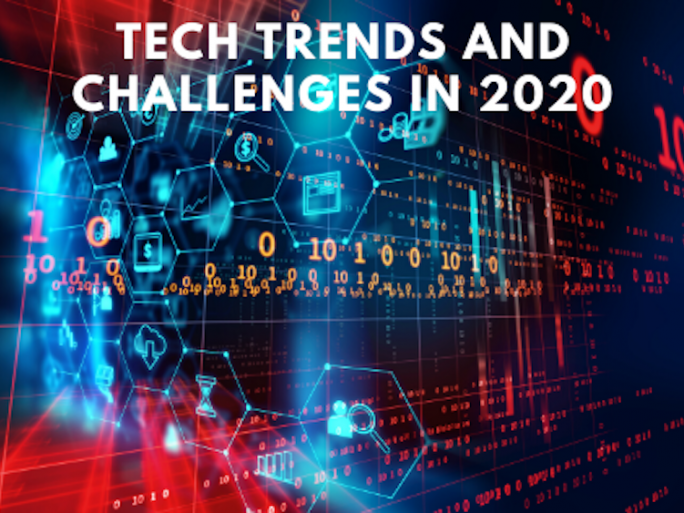Tech Trends and Challenges for CIOs and CTOs in 2020

As 2020 approaches, Silicon asks CIOs and CTOs what the tech landscape will look like and, what challenges they expect to face.
CIO and CTO 2020 will have new challenges and tech trends to consider. Silicon asks CIOs and CTOs what the tech landscape will look like and, what challenges they expect to face.
Dr. Zulfikar Ramzan, CTO, RSA Security.

Based on early results and continued promise, AI and its subdiscipline Machine Learning are here to stay. More and more organisations will roll out these technologies to help optimise their business opportunities. For AI to be successful, however, organisations need data. Ultimately, if AI is the rocket ship then data is the fuel. Therefore, whoever has the best data wins. In the race for data greatness, CIOs and CTOs need to ensure they protect their data, considering both traditional and cutting-edge capabilities.
Firstly, they must process and protect – as data becomes ubiquitous, it will be increasingly important to balance protecting data with processing data. These goals appear antithetical. If data is being processed, it must be accessible, which typically means it cannot be protected during that moment. There have been tremendous recent advances in resolving this conflict through techniques like homomorphic encryption and multi-party computation, but these approaches are not yet ready for widespread use. In the meanwhile, organisations will need to appeal to integrated risk management systems to ensure proper data governance and manage the risks associated with protecting data.
Second, they must be prepared for data protection regulations – compliance regimes involving data protection and privacy, like the GDPR, attach a substantial monetary value to data protection failures. In 2018, organisations scrambled to understand GDPR. In 2019, massive GDPR fines were levied and organisations realised the implications of getting data protection wrong were serious. We expect that in 2020 organisations will take serious steps to address data and privacy concerns.
Next year, we will see capabilities that focus on making AI less of a black box so that the resulting decisions can be more readily understood even by those who are not technical. In the meanwhile, organizations need to focus on who has accessed what, who should have access to what, and ultimately what is being done with that access.
Bruce Penson, Managing Director at Pro Drive IT.

In 2020, organisations will find themselves under immense pressure, as they and their employees are held increasingly accountable for their security practices and response to threats. With many companies looking to beef up their cybersecurity measures in the coming year, we will likely see more and more businesses look toward some form of security assessment. For example, becoming Cyber Essentials certified will demonstrate they are compliant with security and protecting their clients’ data to a government standard.
Phishing is nothing new. But the ways hackers are carrying out attacks are. Although email still dominates, mobile phishing attacks are on the rise — with hackers using SMS (smishing) and live calls (vishing) to pose as familiar individuals or reputable companies and trick users into parting with valuable data. Despite extensive awareness campaigns, these attacks are only going to increase in frequency throughout 2020. A multi-pronged approach which focuses on improving organisational security awareness and credential management is your best bet at tackling this.
Aron Brand, CTO, CTERA.

2020 will mark a notable shift in enterprise IT as the dawn of a new era of edge computing arises. The first-generation model of centralised cloud computing and storage has now run its course, and most of the new opportunities for enterprise data management reside at the edge.
Consider that a growing volume of enterprise data is created in branch offices, on mobile devices and by IoT-enabled smart devices. Gartner estimates that in five years, 75% of data generated and processed by enterprises will exist at the edge rather than in the traditional centralised datacentre or cloud. Such data growth outside the datacentre is a new reality, and it is creating a need for enterprises to deploy computing power and storage capabilities at the network edge, or in other words, edge computing. Edge computing will continue to grow and will likely become mainstream in enterprise IT in 2020.
Herve Mazenod, Managing Director, Insurance and Investment, Gobeyond Partners.

As the pace of both M&A and technology change continues to increase, organisations will need to be more focused on the human angle of transformation. We believe that those who will be the most successful will need to look at their business processes through a more human lens. We want to put human experience at the heart of everything: taking an end-to-end view of the customer journey, leveraging digital technologies with to augment human interactions and engaging colleagues on this journey. Those who succeed in this will ultimately get ahead in 2020 and beyond.
Steve Haighway, COO Europe, IPsoft.

In 2020, expect to see digital workers acting as your Mortgage Advisor or as a Recruitment Specialist in your office. These digital workers will take on time and information-intensive tasks, improving the speed and experience of customer interactions, while reducing the administrative burden on employees.
Looking back at 2019, I’d call it the year of the RPA bubble. The RPA market has been rapidly growing over the past couple of years, with analysts predicting it will exceed $2.9B by 2021 (the Everest Group), reflecting the staggering valuations of some of its key players like UiPath, which was valued at $6.4bn earlier this year.
However, in 2020, I expect this bubble will burst. RPA, while good at automating processes, is limited and will never drive genuine business transformation. This is reminiscent of the dot-com boom, where the firms that listed on the stock exchange did little more than consume vast amounts of investor cash despite showing little prospect of achieving profit. The current expectations for the RPA market are similarly unrealistic – traditional metrics of performance are once again being overlooked and big spending is being seen as a sign of rapid progress.
Paul Dix, Co-Founder, InfluxData.

Developers on the front lines will have a larger role in deciding what technology enterprises choose to adopt in 2020 and beyond. We’ve seen this trend begin the rise of open-source software, which appeals to developers because they can start playing with it immediately and test it out on new projects, without having to commit to a lengthy corporate evaluation and purchase process.
As the pace of software development accelerates and the pool of useful solutions becomes exponentially larger, front-line developers’ intimate knowledge of the products in their niche becomes even more important. They know the products inside and out and have a unique insight into how they perform and can contribute to specific business goals. When people on the ground floor of an organization are the ones constantly testing out different technologies among an overwhelming variety of options, the CIO is no longer the main driver of new tech purchases.
Dave Russell, VP, Enterprise Strategy, Veeam.

In 2020, container adoption will lead to faster software production through more robust DevOps capabilities and Kubernetes will consolidate its status as the de facto container orchestration platform. The popularity of container adoption or ‘containerization’ is driven by two things: speed and ease. Containers are abstract data types that isolate an application from an operating system.
With containers, microservices are packaged with their dependencies and configurations. This makes it faster and easier to develop, ship and deploy services. The trend towards multi-cloud means businesses need data to be portable across various clouds — especially the major providers — AWS, Microsoft Azure and Google Cloud. 451 Research projects the market size of application container technologies to reach $4.3 billion by 2022 and in 2020 more businesses will view containers as a fundamental part of their IT strategy.
James Harvey, EMEA CTO, Cisco AppDynamics.

Any outage, inconvenience or poor digital customer experience will cost UK businesses dearly in 2020. As we enter a new decade, we also enter the ‘Era of the Digital Reflex’ – our use of digital services and applications has evolved to become an unconscious extension of human behaviour, and in turn, consumer expectations about the performance of applications and digital services has sky-rocketed.
Today, 74% of UK consumers are less tolerant of problems with digital services than they were two years ago, and over half switch suppliers when performance issues do occur (according to the recent App Attention Index Report). This highlights just how unforgiving customers have become.
With 5G network transformations in full-swing, next year will see consumer expectations escalate further. Consumers will expect faster download speeds, better video quality and immersive experiences in any location and on any device. Poor performance is no longer acceptable. As businesses develop even more intuitive digital experiences to meet these demands, they must also be ready to deal with the increased back-end application complexity.
Application performance monitoring, machine learning and AI are critical solutions in solving this level of complexity and, enable businesses to have visibility into the performance issue, insight into the route-cause of the anomaly, and the ability to take immediate action and address performance issues before they impact the customer.
The ‘Era of the Digital Reflex’ will bring great opportunities to brands that invest and innovate in their digital customer experience. For those that fail to do this, 2020 will be a tough year.
Richard Grove, Director, Caution Your Blast.

I believe that the way we value data is going to change rapidly in 2020. Until very recently, ‘data’ was generically viewed as a good thing for the modern business; grist to the mill of customer insight and business strategy. Accordingly, companies’ approach to gathering data was to cast the widest net possible, with a shotgun approach to analysis.
New regulations like GDPR have shown this can’t continue. Data is no longer an unlimited source of useful insight. It’s expensive to handle, and if handled incorrectly (or at least, non-compliantly), data can be a toxic burden for a company which opens it up to penalties like fines.
The role of the data scientist will become more refined and central to the running of a successful business, as they’re entrusted to generate even more useful insights from a shrinking amount of raw material. That said, although data scientists will be working with a smaller amount of stored data, it will by its very nature be more relevant data, so their work may even become a little easier!
Fleming Shi’s, CIO, Barracuda Networks.

I believe the biggest security threat in 2020 will be attackers going after misconfigured cloud infrastructures and stealing compute and storage resources. These attacks can be led by insiders as well as by external cybercriminals. The ultimate damage will be data leakage and loss of mission-critical data.
These infrastructure breaches will also lead to or enrich other types of attacks ranging from social-engineered targeted attacks to botnet-enabled volumetric attacks. I think ransomware and spear-phishing attacks will continue to cause serious damage, but I sincerely believe as public cloud infrastructure adoption continues to increase rapidly, the attackers’ interest will be drawn by the potentially awesome available ‘firepower.’
There are a lot of new technologies out there that are both beneficial to us and starting to become weapons. For example, artificial intelligence. It’s something we use to improve efficiency, but now people are using it to power deep fakes and other technologies that make cyberattacks more convincing and even using them to impersonate political figures. That’s manipulation because as humans we’re computing based on the images we see, the voices we hear, and the text we read.
In the next 12 months, particularly as we enter an election year, we’re going to see a barrage of technology like this that shifts from being a cool new tech to super bad weapons. I think social media should be responsible for some of the defensive mechanisms to prevent this from happening. We will also need to build a new cyber workforce to help us defend ourselves from these kinds of attacks.
I think the trend of ransomware attacks against state and local governments will continue to increase in 2020. I also expect to see cybercriminals adapt by finding the critical times to make these demands when government agencies will be under pressure to respond quickly. Now with so many aspects of our elections handled electronically, the bad guys can demand attack and demand ransom at a critical point in our political process, which will get them the most payout and, damage our democracy. That might be the worst-case scenario, but I genuinely feel that’s the direction these attacks are headed.
Aaron Harris, CTO, Sage.

The blockchain is unquestionably an ingenious invention but has gone through what Gartner calls in their hypercycles as the trough of disillusionment. It promised much but has delivered very little to date. Ever since it emerged as the ‘next big thing’, there have been very few meaningful applications for blockchain in the real world.
So, what’s holding blockchain back from mainstream adoption? There are a few elements here, but broadly speaking it comes down to cost, scalability and trust. With industry leaders, such as Amazon or Microsoft committing to building services around blockchain, we will begin to see accelerated adoption as they tackle the issues that have previously stopped it making its way into the mainstream – with real-world solutions coming into play from 2020.
Lee James, CTO, EMEA at Rackspace.

In 2020, there’s going to be significant competition between the three biggest cloud hyperscalers and VMware as they all explore and deliver on how Kubernetes will unlock their potential to be the multi-hybrid cloud provider of choice for customers. For customers, it’s ultimately going to come down to which fits and works best, as well as what gives the best bang for their buck. But this sets us up for an exciting year of new product and service announcements as each of the major cloud companies try to establish themselves as the cloud broker of choice.
Also, in 2020, we’re going to see continued deployments of Edge and Internet of Things (IoT) across multiple industry sectors. I predict specific verticals will lead the way such as the Industrial Edge and the Retail Edge as the main sectors driving adoption and important value. For example, 5G is now available across a few cities in the UK and 5G networks can deliver up to a 90% reduction in power consumption, guaranteeing up to 10 years of battery life for low power IoT devices. This means, for example, that more retailers will have access to smart shelves like the ones Amazon implemented in its Amazon Go stores. This technology uses dozens of sensors to provide real-time inventory visibility and update pricing according to demand.
Jon Wrennall, CTO at Advanced.

The enormous potential of technology is backed up by large quantities of research, showcasing how organisations that digitally transform start to alleviate the pressures of running a business, whilst accelerating business growth and boost staff productivity.
For example, innovative technologies are gaining their place as must-have tools in the day-to-day workplace. According to Advanced’s Annual Trends Survey, 38% of business decision-makers are seeing Artificial Intelligence (AI) in their daily working lives – up from 26% last year – while 29% are seeing chatbots (up from 18%). One in four are seeing wearable technology and 26% are seeing Robotic Process Automation (RPA) – a massive 15% jump in 12 months.
Of course, we can’t forget the Cloud, which has earned its place as the kingpin of the digital world. In fact, Gartner projects the market size and growth of the Cloud services market to reach nearly three times the growth of overall IT services by 2022. There is undoubtedly a growing appetite to adopt innovative technologies, eliminating repetitive and mundane processes and leaving staff to focus on what they do best.
However, the digital transformation journey isn’t that simple. Firstly, there is a raft of regulations – from the General Data Protection Regulation (GDPR) to this year’s Making Tax Digital, which are focusing on organisations to change the way they operate. At the same time, the risk of ‘digital chaos’ comes to the fore when looking at how to manage the change required. Many of the systems needed to underpin these innovative technologies are outdated and simply not fit for the opportunities and challenges of the future.
The challenge is that 48% of business leaders agree that the biggest barrier to organisations modernising their processes or systems is cost. There are a number of other barriers, from disruption to staff’s day-to-day productivity trailing behind at 27%, followed by management being unconvinced by the recommended investment in new technology (25%) and a lack of skills (20%). And 16% blame concerns about project delays. These were all revealed in the same Advanced report,
If these barriers go unaddressed, organisations are at risk of facing digital chaos. Modern digital environments are the backbone of technologies like AI, chatbots and RPA. What’s concerning is that although the cost is seen as the top barrier, the fact is that core legacy business applications, for example, often consume a high share of a company’s IT budget. Many reports indicate that maintaining and operating legacy applications consumes anywhere between 60 and 80% of corporate IT budgets.
Moving to modern integrated systems can eradicate these maintenance costs, whilst delivering the level of robustness, stability, performance and scalability they need to be able to grow and innovate in the future. I predict that 2020 will be the year that organisations will recognise that by reducing these barriers, they will be better placed to make the right decisions about their transformation journey and find an end to the risks of digital chaos.
Justin Fielder, CTO, Zen Internet.

In 2020 we’ll see a technological revolution in how brands interact with their customer base using AI, a clearer picture for 5G (and whether it has lived up to its hype), and a further slowdown for ‘offline’ businesses operating in traditional sectors.
2019 witnessed the colossal rise of AI – and we are beginning to understand its pros, as well as its limitations. Next year we will see how AI will go further, and how it drives customer interactions (think Alexa for customer support) and wider support models such as how businesses drive efficiency and new paradigms. However, the application of AI to networks and infrastructure has not really happened and we believe the challenges around that mean that the promised land of ‘intelligent infrastructure’ is still many years away.
Another much-anticipated evolution in connectivity is 5G, and 2020 will help us reach a judgement on the extent of its success. We don’t expect it to be revolutionary because of limited coverage and challenges with the economic model.
Finally, in 2020 the problems for traditional, ‘off-line’ companies will continue to grow. It’s becoming clear that business models based on the thinking of five, 10 or 20 years ago will lose more market share to ‘internet only’ businesses. Whilst some of these businesses have tried to tinker with the edges of their model, it is not enough to respond to a fundamental change in consumer demand for digitally-led products and services.